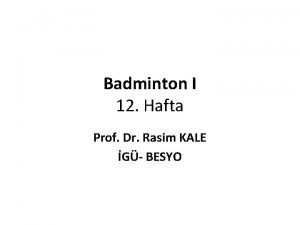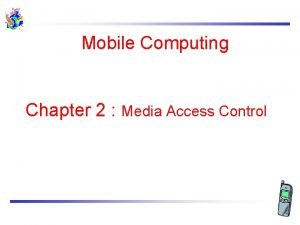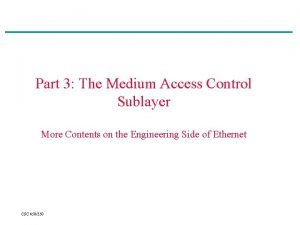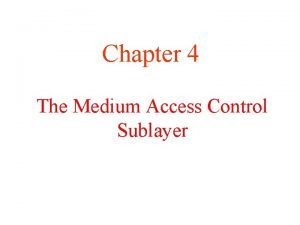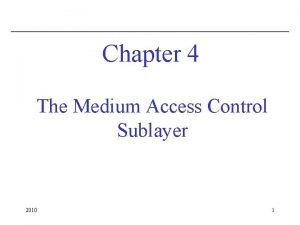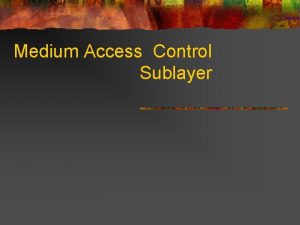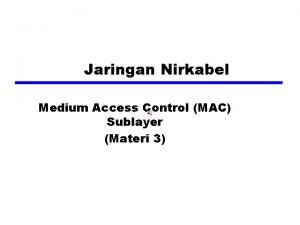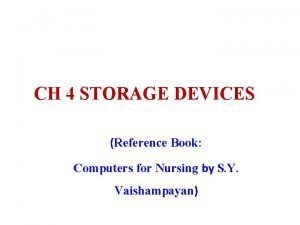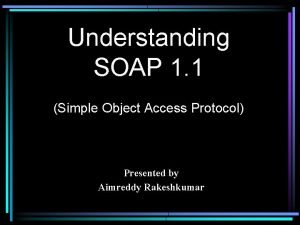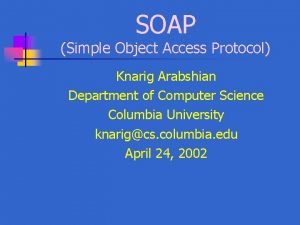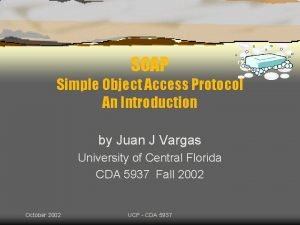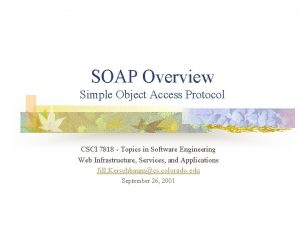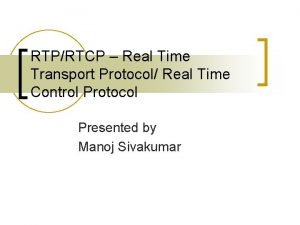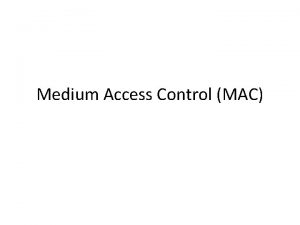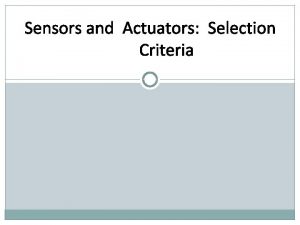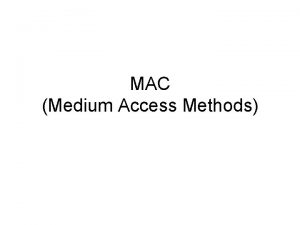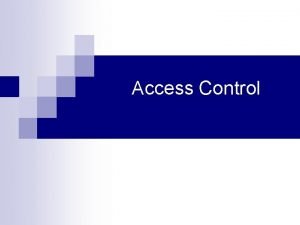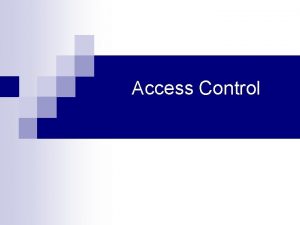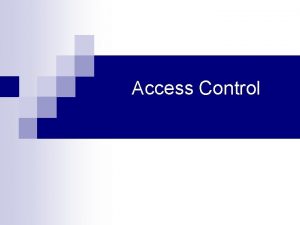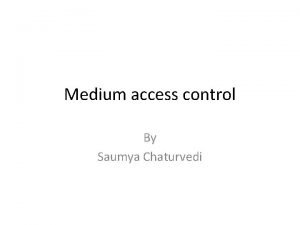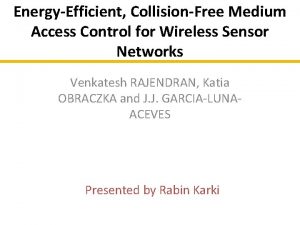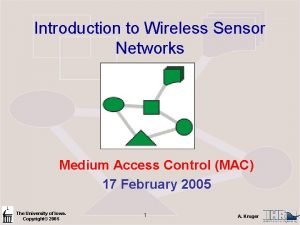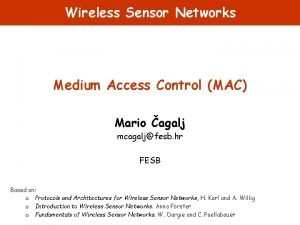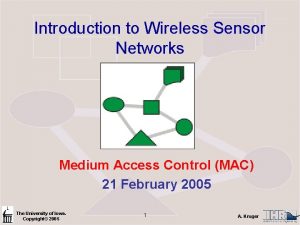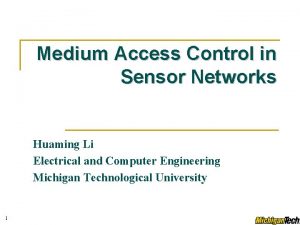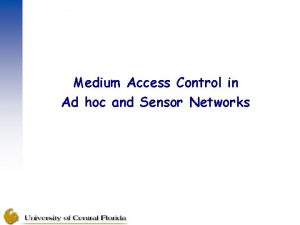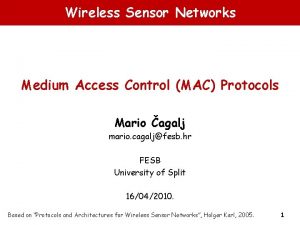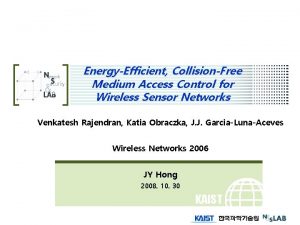SMAC Sensor Medium Access Control Protocol An Energy

























- Slides: 25

S-MAC Sensor Medium Access Control Protocol An Energy Efficient MAC protocol for Wireless Sensor Networks

Outline Introduction Design Considerations Main sources of energy inefficiency Current MAC design S-MAC Protocol implementation in a test-bed Discussion Conclusion and future work

Wireless Sensor Networks Application specific wireless networks for monitoring, smart spaces, medical systems and robotic exploration Battery operated and power limited sensor devices Large number of distributed nodes deployed in an ad-hoc fashion

Design Considerations Primary attributes: Energy Efficiency often difficult to recharge or replace batteries prolonging the network lifetime is important Scalability Some nodes may die or new nodes may join Secondary attributes: Fairness, latency, throughput and bandwidth

Sources of Energy Inefficiency Collision Overhearing Control packet overhead Idle listening

Existing MAC Design Contention-based protocols • IEEE 802. 11 – Idle listening • PAMAS – heavy duty cycle of the radio, avoids overhearing, idle listening TDMA based protocols Advantages - Reduced energy consumption Problems – requires real clusters, and does not support scalability

Design goal of S-MAC Reduce energy consumption Support good scalability Self-configurable

S-MAC Tries to reduce wastage of energy from all four sources of energy inefficiency w Collision – by using RTS and CTS w Overhearing – by switching the radio off when transmission is not meant for that node w Control Overhead – by message passing w Idle listening – by periodic listen and sleep

Is the improvement free of cost? No In exchange there is some reduction in per-hop fairness and latency But does not reduce end-to-end fairness and latency Is it important for sensor networks?

Network Assumptions Composed of many small nodes deployed in ad hoc fashion Most communication will be between nodes as peers, rather than a single base station Nodes must self-configure

Application Assumptions Dedicated to a single application or a few collaborative application Involves in-network processing to reduce traffic and increase life time Applications will have long idle periods and can tolerate some latency

Components of S-MAC Periodic listen and sleep Collision and Overhearing avoidance Message passing

Periodic Listen and Sleep Each node goes into periodic sleep mode during which it switches the radio off and sets a timer to awake later When the timer expires, it wakes up Selection of sleep and listen duration is based on the application scenarios Neighboring nodes are synchronized together

Contd…. Nodes exchange schedules by broadcast Multiple neighbors contend for the medium Once transmission starts, it does not stop until completed A B C D

Choosing and Maintaining Schedules Each node maintains a schedule table Initial schedule is established w Synchronizer w Follower Rules for joining a new node

Maintaining Synchronization Needed to prevent clock drift Periodic updating using a SYNC packet Sender Node ID Next-Sleep Time SYNC Packet Receivers adjust their timer counters Listen interval divided into two parts Each part further divided into time slots

Timing Relationship

Collision Avoidance Similar to IEEE 802. 11 using RTS/CTS mechanism Perform virtual and physical carrier sense before transmission • RTS/CTS addresses the hidden terminal problem • NAV –indicates how long the remaining transmission will be.

Overhearing Avoidance Interfering nodes go to sleep after they hear the RTS or CTS packet The medium is busy when the NAV value is not zero All immediate neighbors of sender and receiver should go to sleep

Message Passing What is a message? Transmitting a message as a long packet High retransmission cost Fragmentation into small packets High control overhead Ø Solution Ø Disadvantage

Protocol Implementation Test bed • Rene motes developed at UCB • They run Tiny. OS, an event–driven operating system w Two types of packets • Fixed size data packets with header(6 B), payload(30 B) and CRC(2 B) • Control packets (RTS and CTS), header(6 B) (2 B) CRC

MAC modules implemented Simplified IEEE 802. 11 DCF – physical and virtual carrier sense, backoff and retry, RTS/CTS/DATA/ACK packet exchange and fragmentation support Message passing with overhearing avoidance The complete S-MAC – all the features are implemented

Conclusions and Future work S-MAC has good energy conserving properties comparing to IEEE 802. 11 Future work Analytical study on the energy consumption and latency Analyze the effect of topology changes

Our Project Implementing S-MAC on Tiny. OS 1. 0 Incorporating multicasting with S-MAC

Directed Diffusion and S-MAC can be incorporated into the directed diffusion paradigm
 Badminton smaç vuruşu
Badminton smaç vuruşu Smac recipe
Smac recipe Fixed tdm in mobile computing
Fixed tdm in mobile computing Medium access control sublayer
Medium access control sublayer Medium access control sublayer
Medium access control sublayer Medium access control sublayer
Medium access control sublayer Terminal access controller access-control system
Terminal access controller access-control system Terminal access controller access-control system
Terminal access controller access-control system Cold and hot media
Cold and hot media Vydj
Vydj Medium access sublayer
Medium access sublayer Medium access sublayer
Medium access sublayer Channel allocation problem in data link layer
Channel allocation problem in data link layer Sublayer mac
Sublayer mac Optical disc
Optical disc Ultrasonic sensor with servo motor
Ultrasonic sensor with servo motor Syntax soap
Syntax soap Knarig arabshian
Knarig arabshian Simple object access protocol
Simple object access protocol Simple object access protocol service
Simple object access protocol service Energy energy transfer and general energy analysis
Energy energy transfer and general energy analysis Energy energy transfer and general energy analysis
Energy energy transfer and general energy analysis Medium energy ion scattering
Medium energy ion scattering Skinny protocol
Skinny protocol Real time control protocol
Real time control protocol Domain host control protocol
Domain host control protocol
